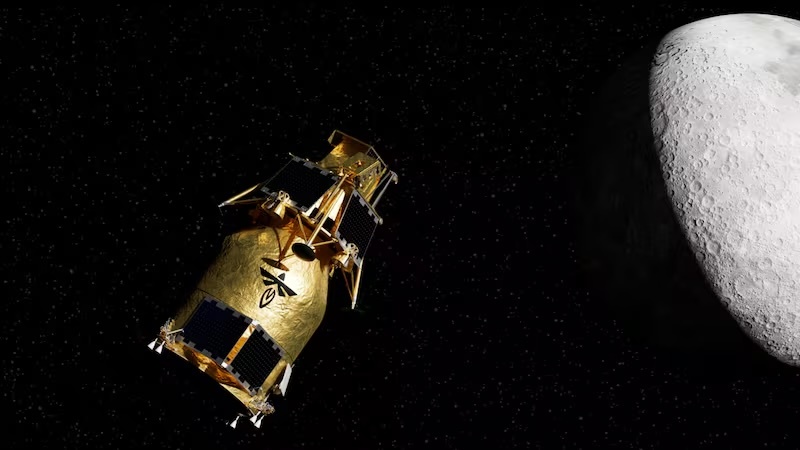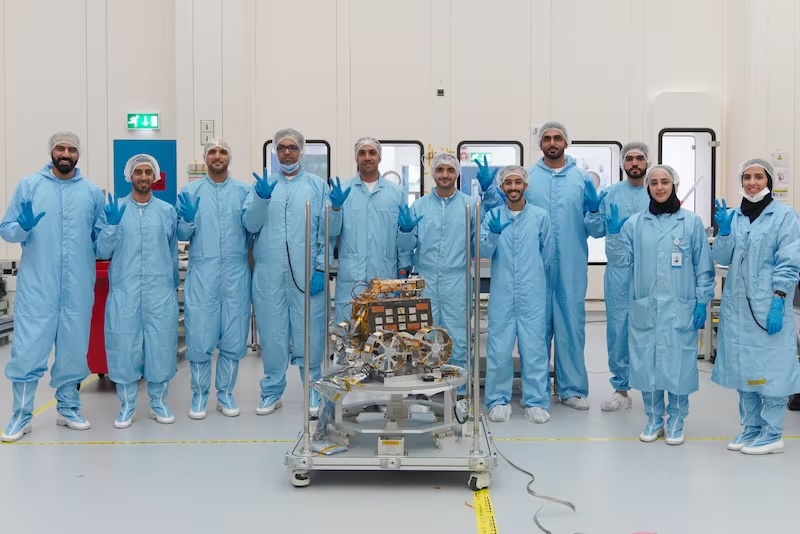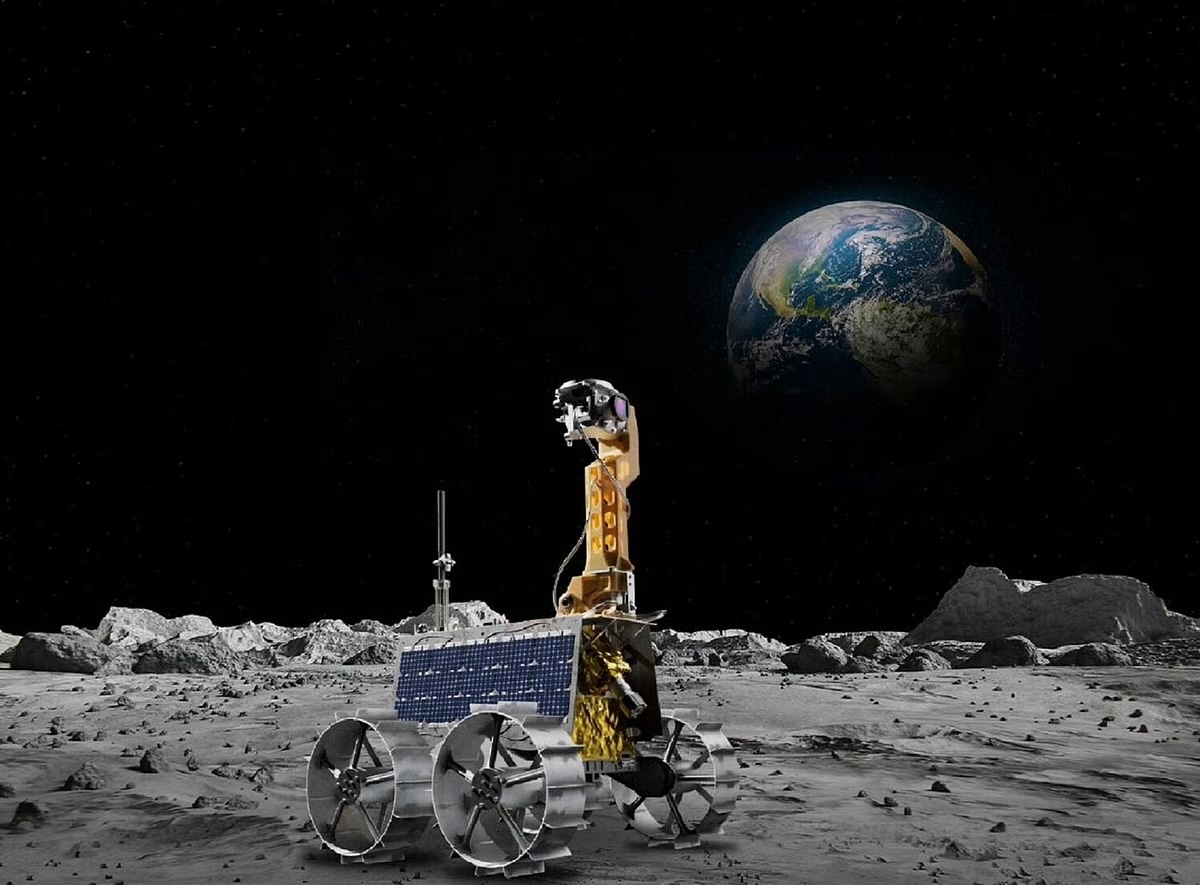23.05.2025
Sheikh Hamdan says UAE to attempt to land on far side of the Moon
This will be the Emirates' second attempt to reach lunar surface with small robotic rover

A rendering of Firefly's Blue Ghost 2 mission. Photo: Firefly Aerospace
The UAE is about to attempt to become only the second nation to land on the far side of the Moon, Sheikh Hamdan bin Mohammed, Crown Prince of Dubai, Deputy Prime Minister and Minister of Defence, has said.
Sheikh Hamdan made his comments in the wake of a deal between the Mohammed bin Rashid Space Centre (MBRSC) and the US-based Firefly Aerospace to provide the payload delivery services for the Rashid 2 rover, forming a vital part of the Emirates Lunar Mission scheduled for 2026.
"The mission is set to make the UAE only the second country in history to attempt a landing on the Moon's far side, placing the nation at the forefront of space exploration," Sheikh Hamdan said on X on Thursday.
"The UAE continues to strengthen its role as a major global player in advancing space exploration. Driven by the talent of our youth, the UAE’s journey in space reflects the same ambition and excellence that define our progress on Earth."
Only one country has successfully landed on the far side of the Moon to date. China made history in 2019 when its Chang'e-4 mission landed in the Von Karman crater.
MBRSC has now selected Firefly Aerospace to carry its second lunar rover, Rashid 2, to the Moon. It will travel into space aboard the Blue Ghost 2 lander, currently scheduled for launch in early 2026 for a landing attempt on the Moon’s far side - the unlit part - for a 10-day mission.
It will be the space centre’s second attempt to land a rover on the Moon following the unsuccessful Rashid 1 mission in April 2023. The first rover, part of Japan’s Hakuto-R Mission 1, was lost when the lander crashed into the lunar surface.
Firefly is one of only two companies that has managed to land safely on the Moon. Its Blue Ghost 1 vehicle touched down on March 2. Intuitive Machines, another US company, carried out the first successful private mission to the Moon’s surface last year.
Both companies are part of Nasa’s Commercial Lunar Payload Services (CLPS) programme, which awards contracts to companies developing lunar vehicles that can deliver scientific and technology payloads to the surface.

Firefly’s second mission to the Moon involves the Elytra Dark orbital vehicle, a spacecraft that will deploy the Blue Ghost 2 lander and the European Space Agency’s Lunar Pathfinder satellite. From there, Blue Ghost 2 will attempt a landing on the lunar surface.
Apart from the UAE's Rashid 2, the landing vehicle is carrying technology from a few other clients, including Nasa and the US Department of Energy, Nasa’s Jet Propulsion Laboratory and the Australian Space Agency.
The Rashid 2 rover was designed to achieve the same targets that the initial one was meant to carry out. These include studying regolith, or lunar soil, testing new materials for lunar exploration, capturing high-resolution images and analysing the lunar surface environment.
Quelle: The National
+++
UAE takes giant leap with Rashid 2 Rover mission to the moon in 2026
The country signs landmark agreement with US-based Firefly Aerospace to deploy the country's Rashid 2 Rover on the far side of the moon, as part of its Lunar Mission

Image used for illustrative purpose. Photo: File
The UAE's space ambitions received a boost with Mohammed Bin Rashid Space Centre (MBRSC) signing a landmark agreement with US-based Firefly Aerospace to deploy the country's Rashid 2 Rover on the far side of the moon, as part of its Lunar Mission.
Under the agreement, Firefly Aerospace will provide the lunar lander to deploy the Rashid 2 Rover. The Rashid 2 Rover will be deployed to the far side of the Moon on Firefly Aerospace’s Blue Ghost lander stacked on the Elytra Dark orbital vehicle. The Rashid 2 Rover will join Blue Ghost Mission 2, in 2026, which will be Firefly Aerospace’s second lunar mission, alongside payloads from Australia, the European Space Agency (ESA), and Nasa.
"The UAE’s mission to explore the far side of the Moon places our nation among a select group of countries advancing the frontiers of lunar exploration," Sheikh Hamdan bin Mohammed bin Rashid Al Maktoum, Crown Prince of Dubai, Deputy Prime Minister and Minister of Defence of the UAE, who witnessed the signing, said in a statement on Thursday, May 22.
"Our objective is not only to reach new destinations in space, but to generate meaningful knowledge that contributes to humanity’s understanding of the universe. The agreement with Firefly Aerospace reflects our strategy of forging strategic global collaborations that advance our long-term scientific and space technology ambitions,” added Sheikh Hamdan, who is also the President of MBRSC.
“We are committed to shaping a sustainable space industry ecosystem that fosters innovation, facilitates international knowledge exchange, and supports the continued growth of the UAE’s scientific and technological leadership. Through missions like these, the UAE is set to further strengthen its position in the global space sector as a major player in expanding the horizons of discovery,” the Dubai Crown Prince elaborated.
Jason Kim, CEO of Firefly Aerospace, said, “On the heels of Firefly’s flawless moon landing and operations, our team is looking forward to collaborating with the UAE and further expanding our representation of Artemis Accords nations on this groundbreaking mission to the far side of the Moon. We’re honoured to support the international space community with our versatile Blue Ghost and Elytra spacecraft that can stack together to provide unique access to both lunar orbit and the lunar surface.”
Scientific goals
MBRSC has outlined a set of ambitious scientific goals for the Rashid 2 Rover, which will demonstrate lunar surface mobility on the far side of the moon — where terrain and communication pose greater challenges than the near side. As part of the mission, the rover will undergo the material adhesion determination experiment, using various materials on its wheels to evaluate their durability against lunar dust. The findings can inform the design of future technologies such as spacesuits, habitats, and other critical infrastructure.
Equipped with multiple cameras and scientific probes, the Rashid 2 Rover will study the moon’s plasma environment, geology, and thermal conditions. It will also investigate the properties of lunar soil, surface structure temperatures, and the lunar photoelectron sheath, which will provide valuable insights to support future in-situ resource utilisation and advance further exploration of deep space. The rover will further carry a radio transmitter to communicate with other payloads during the mission.
The Emirates Lunar Mission forms a pivotal part of the of the broader space exploration strategy under the UAE’s National Space Programme, that prioritises the advancement of scientific knowledge, the empowerment of future generations, and the strengthening of international cooperation.
Quelle: Khaleey Times
